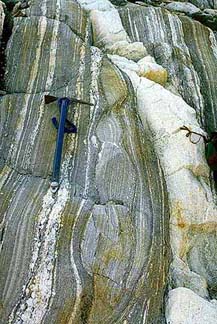Dyke
Dykes (English) or Dikes (American) are plate-like, mostly far-reaching rock bodies made of igneous rock that fill larger crevices and cut or cross the surrounding rock. The term has recently partly replaced the German term Gesteinsgang , which differs from the Anglo-American term in some areas of geological terminology.
Forms of magmatic dykes
The discordant nature of igneous dykes causes different manifestations:
- Multiple dykes are contiguous rock bodies that are primarily formed from multiple intrusions of the same material. Examples of this form are the sheet-dike complexes of the oceanic crust , which consist of numerous nested dolerite dykes .
- Compound dykes are interconnected bodies of rock formed from multiple intrusions of different materials. For example, an original, low-silicon dolerite dyke can be intruded in a later phase by a silicon-rich kersantite .
- Ring dykes cut the earth's surface in a ring, circular or arc shape
- "Cone Sheets" are ring-shaped corridors that correspond to an inverted cone , that is, they become narrower with increasing depth. They arise when a caldera collapses through the penetration of magma into the ring-shaped fractures.
Igneous rocks of average size dykes have a medium grain size , that of smaller dykes is predominantly fine-grained , the very large dykes rather coarse-grained. This is related to the different solidification times , which are responsible for the size of the crystals formed .
Sedimentary dykes
A special form of dykes is sedimentary formation, the so-called sedimentary or clastic dykes. They can arise through various mechanisms, in that sediment penetrates from below, from the side or from above into crevices that have formed in the affected sediment or sedimentary rock. So far, the following mechanisms have been proposed for the formation of crevices and thus sedimentary dykes:
- Different settlement of sediment under a cover layer or over basement structures, resulting in crevices
- Slipping of sediment on sloping ground or similar instabilities caused by gravity
- Disturbance activity during the deposition of sediments
- Earthquake.
The gaps are filled from above as part of normal sedimentation. On the other hand, the filling sediment is actively involved in the formation of the sediment-filled crevices when the pore water pressure is greater than the breaking strength of the overlying impermeable rock, or when the pore water pressure is increased , in an alternatingly permeable, incompletely solidified rock package - e.g. a sequence of sandstones and claystones sudden change in pressure such as an earthquake occurs. Coarse-grained and permeable material, which is mobilized due to the large pore volume , penetrates from below into weak zones or crevices in the impermeable rock.
A subgroup of the sedimentary dykes are the Neptunian dykes , which arise from the mostly downward-facing backfilling of crevices in carbonate rocks .
Occurrence
Igneous dykes usually occur together with larger igneous rock bodies and often form large swarms of radial or parallel structure ( dike swarms ). One of the largest Dyke occurrences in Europe is the Hebridean gauntlet with almost 600 km in Ireland , Northern England and Scotland . Other occurrences are the approximately 500 km long Great Dyke in Zimbabwe , the Mackenzie Dike Swarm in the Northwest Territories of Canada , or the formerly contiguous Dykes in the Large Igneous Province of the Karoo Basalts in South Africa, in the Ferrar Group on the Ross Sea in Antarctica and in the volcanic Chon Aike province in Patagonia . Smaller occurrences are found in widespread distribution around the world. In Germany, Dykes are exposed in the young volcanic areas of the Vulkaneifel , as individual or group occurrences in the Rhenish Slate Mountains and in many other areas.
See also
Literature and web links
- Erik Flügel: Microfacies of carbonate rocks. Springer Verlag, 2004, ISBN 978-3-540-22016-9 . Pp. 217-223: Sediment Filled Fissures: Neptunian Dikes and Fissure Fills.
- Ned Frost, Dan Carpenter and Charles Kerans: Platform-Margin Trajectory as a Control on Neptunian Dike Distributions, Devonian Reef Complexes, Canning Basin, Western Australia. Fractured Reservoir Controls, 2006 AAPG International Conference and Exhibition, (November 5-8, 2006) Technical Program, Lecture Summaries
- HH Read, J. Watson: Introduction to geology. Vol. 1: Principles. Macmillan, London, 1962
Web links
Individual evidence
- ^ Wolfgang Frisch, Martin Meschede: plate tectonics . Scientific Book Society, 2005, ISBN 3-534-15834-2 , pp. 69 f .
- ^ Ian West: Geology of Great Britain - Introduction
- ↑ M. Pilkington and WR Roest (1998): Suppressing Varying Directional Trends in Aeromagnetic Data , Geophysics, 63, pp. 446–453 ( Web version from the Geological Survey of Canada ( Memento of the original from July 8, 2007 in the Internet Archive ) Info: The archive link was inserted automatically and has not yet been checked. Please check the original and archive link according to the instructions and then remove this note. )
- ↑ Richard E. Ernst and Kenneth L. Buchan: Large Igneous Provinces - Database ( Memento of the original from August 20, 2007 in the Internet Archive ) Info: The archive link has been inserted automatically and has not yet been checked. Please check the original and archive link according to the instructions and then remove this notice. , Geological Survey of Canada website
- ^ Teal R. Riley and Philip T. Leat (1999): Large volume silicic volcanism along the proto-Pacific margin of Gondwana: lithological and stratigraphical investigations from the Antarctic Peninsula , Geological Magazine 136/1, pp. 1-16 Abstract

